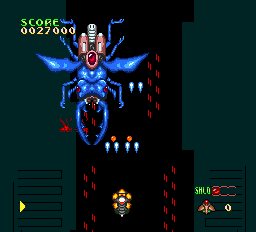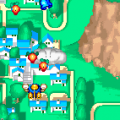The TurboGrafx-16 is known for its vast library of shoot-em-ups, so it can be difficult for the more obscure ones to stand out. 1990’s Cyber Core is the first time developer Alfa System gave the genre a spin, and as a result, it lacks the ambition or memorable absurdity found in the company’s future titles such as Download and Shikigami no Shiro. Compared to contemporaries like Air Zonk and Blazing Lazers, it can’t quite compete in terms of visual splendor or rockin’ tunes either. Where Cyber Core actually can compete, however, lies with its unusual world and aesthetic alongside a power-up system that rewards skillful play while still incorporating significant risk – combine those elements with solid fundamentals and you have a recipe for an ultimately worthwhile shoot-em-up.
The world of Cyber Core can be likened to Nausicaa of the Valley of the Wind or the Earth Defense Force series, where the planet as it we know it has been taken over by giant alien bugs. As the enforcer named “Rad Ralph” (yes, really), your job is to defeat the bugs and reclaim the Earth. Perhaps taking a bit of inspiration from Franz Kafka’s The Metamorphosis, Rad Ralph is half-human and half-insect as a result of his fusion with the unexplained Chimera lifeform. This is the game’s justification for its power-up system, which has your ship metamorphose into different forms by collecting insect eggs. In the Japanese version of the game, the protagonist has the less ridiculous name of “Mellange Kato”.
At first glance, everything seems straightforward enough – your ship is equipped with a standard projectile as well as bombs meant to hit targets on the ground, much like Xevious, and getting hit once will send you back to the nearest checkpoint. Once you encounter the flying green pods that show up at every checkpoint, things become more interesting. After shooting the pod enough times, it’ll forfeit one of four different power-ups, each of which changes your ship into a new form. By collecting multiple power-ups of the same color, you can continue to evolve your ship into increasingly powerful forms, though grabbing a different color will kick you all the way back down to that color’s first form, meaning consistency is key. Each form is associated with a different geologic time period within Earth’s history (Precambrian -> Paleozoic -> Mesozoic -> Cenozoic), and each upgrade imbues your ship with an increasingly elaborate projectile and more bombs per shot. If you get hit after metamorphosing, you’ll devolve into the previous form, but you won’t actually die until you get hit in your Precambrian form, making this system essential for defense as well. Successful evolutions also grant a unit of shield energy (you max out at three) that will always be sacrificed before your form is downgraded, so a player that is doing exceptionally well can take up to seven hits before dying. Metamorphosis isn’t all fun and games though, as your newfound power will also burden you with a much larger sprite and slower movement, oftentimes making it more difficult to avoid the game’s many fast enemies.
The red power-up turns you into a swallowtail butterfly that’s capable of shooting a three-way ripple shot much like the one seen in the Gradius series. Collecting blue power-ups transforms you into a beetle armed with a five-way spread shot made of windmill-shaped bullets, great for covering most of the screen at all times. When you become a mantis via the green power-up, you’ll be assisted by two curved, blade-like projectiles that cover your ship from both sides, giving this form a unique duality of offense and defense compared to the others. Lastly, collecting yellow power-ups turns you into the hornet, which is equipped with a narrow but powerful triple laser shot, perfect for tearing through tougher foes. Disappointingly, the red swallowtail is the only form that gets a different bomb animation.
While the stages in Cyber Core are lacking in setpieces and gimmicks, they do an impressive job of throwing different obstacles at you while also providing a bit of environmental storytelling. The first step of the journey serves as a typical but effective introduction that has you flying over water as you contend with smaller bugs like flies, water striders, and moths alongside some aquatic creatures like jellyfish. Once you make it to the next stage, you’ll get to see the destruction wrought by the insects firsthand as you fly over a massive ruined city, which does a great of job of demonstrating the high stakes of the mission to the player. The next few levels have you moving past forest and desert areas in order to finally make it to the subterranean home of the insects, where you’ll first get to invade an elaborate city built out of anthills, a striking representation of their total dominance. Once you’ve dug deep enough to make it to the tunnels, you’ll have to push through an onslaught of robots that the insects have apparently been hiding all this time. For the finale, things get even weirder as you fly over what appears to resemble entrails as you contend with an exhausting gauntlet of incredibly fast enemies that swoop in from the sides and can decimate an upgraded ship in seconds.
Each level is backed by a thoughtful variety of insects to encounter, from common bugs like ticks, vinegar flies, and bees, to creepier ones like nematodes and centipedes. This diversity gives each level a very welcome sense of unpredictability, and the bosses complement this nicely as well, featuring massive insects like a stag beetle that shoots lasers and a giant fly that’s supposed to be Beelzebub himself. The first boss is also notable for being nearly identical to the Ohmu in Nausicaa, further solidifying it as a source of inspiration. Environments are rather blandly colored and there isn’t much in the way of animation or background variety per stage, but the way that the game depicts a descent from (relative) normalcy into insect-laden madness does a lot to give the game its standout flavor.
Despite all of the potential power at your fingertips, Cyber Core pushes back with a harsh challenge that occasionally crosses the line into being unfair. Enemies come in packs and are fast and aggressive in equal measure, with an annoying emphasis on firing projectiles that curve suddenly or home in on you. In fact, certain hazards are fast enough that advance knowledge almost feels necessary to avoid damage. While this keeps things engaging for players accustomed to the genre, it does create an issue where less skilled players won’t get to appreciate the power-up system because of how difficult the game can be. In a bizarre case of balancing, the bosses in the first half of the game tend to be harder than the ones in the latter half due to their particular weaknesses. Certain bosses, such as the Sidewinder in stage two and King Nematoda in stage three, can only be damaged by bombs, which are both weaker than your standard shot and require accurate aim to actually deal damage. If you’re stuck with the Precambrian ship for these bosses, you’ll have to whittle their health away with just a single bomb, which takes far too long to do and gets difficult to aim properly with all of the projectiles that you have to weave between. Alongside limited continues and a checkpoint system, it’s likely that many players won’t see past the first few levels without throwing in the towel.
The game does contain ways to adjust the difficulty via a password system, but it’s weirdly esoteric, requiring a specific button combination at the title screen plus finding the desired passwords somewhere online since they’re not in the manual. Some potential options include difficulty level adjustments, passwords for each level, the ability to start off with a fully metamorphosed ship of your choosing, and even the ability to adjust the screen size to more closely resemble what the game would look like in an arcade setting. There’s also a button combination for infinite continues, so most players will definitely want to dedicate that to memory before starting.
Cyber Core’s soundtrack was composed by Toshio Murai and Masahiro Teramoto, and it’s a pretty good batch of songs. Most of the tracks have some degree of energy and excitement that pairs well with the action at hand, and the way that the intro transitions from silence into the first stage’s track right as the game tells you that the mission has started is a great touch as well. Some tracks are notably evocative, such as the ominous sounding boss theme and the song for the final stage that emphasizes the approaching finality of the conflict with a dramatic tone.
A year later, Cyber Core was ported over to the Sharp X68000, and this version has a host of improvements. As a result of the more powerful hardware, the graphics have been improved, there are more instances of parallax scrolling, and there are new animations for the intro and ending. Several sprites, such as the Precambrian ship and several different foes, had their color palettes altered and enhanced. The music benefits greatly from the X68000’s sound capabilities, which add a harsher sound backed by plenty of bass to give each track a lot more intensity. More enemies tend to be displayed onscreen here, which can make some sections of the game even more hectic than they already were. However, this version also rebalances a couple of sections to be more reasonable. In stage seven, the sequence where you’re fenced in by laser turrets as you fight giant, flame-throwing robots was changed so that the turrets are placed in a more haphazard way, giving you far more space to maneuver. An incredibly welcome change was made for the final stage, which tweaks the blue blob-like enemies so that they don’t fly in at their original ludicrous speed, instead opting for a greater number of them that move far more slowly. This version is also the only one of the two to get a re-release of any kind and is available on the Project EGG digital download service.
Screenshot Comparisons


